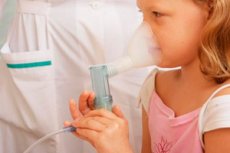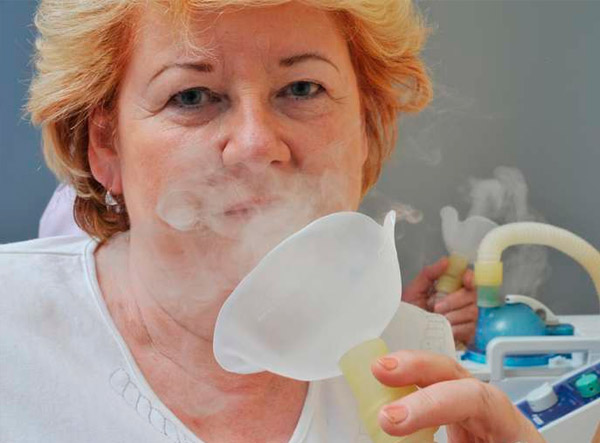Inhalation in adenoids: solutions
Last reviewed: 23.04.2024

All iLive content is medically reviewed or fact checked to ensure as much factual accuracy as possible.
We have strict sourcing guidelines and only link to reputable media sites, academic research institutions and, whenever possible, medically peer reviewed studies. Note that the numbers in parentheses ([1], [2], etc.) are clickable links to these studies.
If you feel that any of our content is inaccurate, out-of-date, or otherwise questionable, please select it and press Ctrl + Enter.

In childhood, adenoids are one of the most common causes of ENT diseases. They represent the growth of the unpaired tonsil, which is located on the back wall of the nasopharynx.
Nasopharyngeal tonsils perform several functions at once: hematopoietic and protective. However, their increase causes discomfort and can provoke a number of serious pathologies, including loss of hearing. With enlarged tonsils, the child has difficulty breathing through the nose.
To date, the most effective and affordable method of control is inhalation in adenoids.
Technique of the inhalations for adenoids
To carry out inhalation in adenoids in children was successful, it is necessary to take into account the existing rules:
- It is important that during the procedure the child is in a sitting position;
- should be explained to the child so that he inhales and exhales slowly, using a special mouthpiece;
- the duration of the procedure is 10-15 minutes on average. If necessary, the doctor will burn it to prolong it or vice versa;
- It is not necessary to use essential oils, because they can clog the inhaler;
- Do not go out immediately after the procedure.
How does inhalation work?
The procedure has a symptomatic effect. It prevents the progression of the disease, thereby contributing to the improvement of the child's condition. It is carried out not only during the calm course of the illness, but also during exacerbations.
Specialists distinguish four stages of the disease. Many are interested in whether it is possible to do inhalations with adenoids if the disease was started. The most effective procedure will be in the first or second stage. During this period adenoids yield to conservative treatment. If the disease has reached the third or fourth degree, surgical intervention is inevitable. Therefore, the first symptoms should be addressed to a doctor.
In the initial stages of inhalation, the following effects:
- reduce the puffiness of the tonsils;
- improve blood microcirculation and lymph drainage;
- strengthen the protective function of the immune system;
- prevent the development of inflammation.
Types of inhalation
The main task of medical inhalations is to reduce the size of adenoids. To date, there are three main types of procedure:
- Steam inhalations for adenoids. Modern medicine does not recommend this procedure to children. An unpleasant consequence after the procedure can be a burn of a thin mucous toddler. Also, high temperature provokes vasodilation and swelling;
- Dry inhalation in adenoids. Essential oil is required for the procedure. You can use fir, sea-buckthorn, cypress, eucalyptus or mint. To facilitate breathing, you need to drip 3-5 drops of oil on a dry handkerchief and let the baby breathe. That at night, enlarged adenoids do not interfere with the child to sleep, a handkerchief soaked in a small amount of essential oil, you can leave next to the pillow in his crib;
- Saline inhalations for adenoids. For the procedure, only sea salt is used, since it contains a large amount of mineral and iodine. 1 kg of salt should be well heated in a dry frying pan, you can use another container. After - add 3-5 drops of essential oil (eucalyptus, fir or mint). Then warm sea salt should be poured into a bowl or a cup and give the child that he would breathe in pairs. It should be explained to the baby that the breaths must be deep.

Using a nebulizer with adenoids
According to pediatricians, the most effective and absolutely safe for children are nebulizer inhalations in adenoids. This method has a number of undeniable advantages:
- absence of risk. Unlike steam inhalations, the nebulizer prevents the risk of burning the mucous membrane. Also, its design is quite simple and understandable, so there will be no difficulties with the procedure;
- high efficiency. The inhaler dissolves medicinal substances into fine dust and contributes to the ingestion of a large number of nutrients. This speeds up the healing process;
- the opportunity to use effective medications that are much more effective.
In order for the procedure to produce the desired effect, special attention should be given to the preparation:
- Carry out the procedure about an hour after eating;
- Monitor the temperature. At an elevated body temperature, it is advisable to refuse inhalation;
- Prepare medicines. If they are stored in the refrigerator, one hour before the procedure, the preparations should be taken out so that they warm up a little;
- Pick up loose clothing that will not interfere with the breathing of the child.
What are the inhalation solutions used for nebulisers in adenoids?
To conduct inhalation saline with adenoids used drugs exclusively in liquid form. Fizrastvor acts as a solvent. It is important to make sure that it is sterile. Also it can be replaced with mineral water without bubbles.
Inhalations with Cycloferon in adenoids. For the procedure, the preparation is suitable in the form of a solution intended for injections. Dosage for one procedure: 4 ml saline and 1-2 ampoules of medication. Drugs should be mixed thoroughly and poured into a nebulizer. The procedure lasts about seven minutes. It is important that the child takes a slow breath through his nose and exhales with his mouth. The general condition of the child will improve after 2-3 procedures.
Inhalation with fluimycil. The drug can be used for inhalations for children up to a year. Helps reduce the inflammatory process in the nasopharynx. The composition of the drug includes mucolytic agent acetylcysteine.
To prepare a solution for inhalation, prepare the medicine. In the pharmacy, Fluimutsil is sold in the form of a powder, and the kit contains water for injections. The water-miscible powder should be added to the physiological saline with the calculation of 1.25 medicines per 1 ml of saline. The duration of inhalation is 6-10 minutes.
Inhalations with miramistin in adenoids. Miramistin is an antiseptic drug and is widely used in modern medicine. It is non-toxic, therefore suitable for inhalation to children. The drug contributes to the destruction of bacteria and prevents them from spreading throughout the body.
Preparation of the solution: for children under 12 years of age, the dosage is 2 ml of saline and 1 ml of Miramistine. The duration of the procedure is an average of 10 minutes. You need to spend it two / three times a day.
Inhalation with aminocaproic acid in adenoids. The drug is non-toxic and is rapidly excreted from the body. It helps to remove the edema and improve the patient's condition. Inhalation is performed with a nebulizer. For this purpose, a mixture of saline and ACC (1: 1) should be placed in the special container of the inhaler. For one-time inhalation, 2 ml of medication is sufficient. One session lasts 5 minutes.
Inhalations with derinatomas in adenoids. Derinat is an immunomodulatory drug that strengthens the protective function of immunity and allows the body to fight harmful bacteria. Promotes recovery of the mucosa, removes puffiness, provides protection to healthy cells. According to the patients' reviews, the drug not only contributes to the destruction of the infection, but also helps the child's organism to resist other diseases.
Inhalations with this drug can be done even in infants. In a special container of the inhaler, a couple of drops of the drug should be diluted with saline solution. The duration of the procedure is from 5 to 7 minutes. The course of treatment is determined by a specialist.
Pulmicort for inhalations in adenoids. The drug helps improve breathing and relieves swelling. For the procedure, the drug must be dissolved with saline solution. The duration of the first procedures is approximately 3-4 minutes. Later they can last up to 7 minutes. Inhalations can be carried out for a week.
Inhalation of eucalyptus in adenoids. For the procedure, 3 drops of ethereal eucalyptus oil should be dissolved in 1 ml of saline. The procedure is sufficient to conduct once a day. Eucalyptus will remove unpleasant symptoms, remove the edema and facilitate breathing.
Inhalation of interferon in adenoids. Interferon is an immunomodulating drug. Strengthens the immune system and improves the general condition of the small patient. On 2 ml of saline solution take 1 ampoule of interferon. The standard course of treatment lasts two weeks. Depending on the condition of the child and the stage of adenoids, the attending physician may prolong it.

Contraindications to the procedure
Inhalation is a type of treatment for adenoids. The procedure has a number of advantages and disadvantages. Despite the fact that nebulizer inhalations are absolutely safe, there are a number of contraindications for carrying out:
- pathology of the cardiovascular or respiratory system;
- neoplasms that are found in the brain;
- frequent bleeding from the nose;
- bronchial asthma;
- 3 or 4 stage of the disease;
- heat.
If the child has the first symptoms of the disease, it should be urgently shown to the doctor. The earlier the parents start treatment, the more likely they are to beat the disease with conservative methods.
Complications after the procedure
To avoid complications after the procedure, do not spend it when the child has a fever. Also it is necessary to consult with a specialist. Having evaluated the patient's condition, the doctor will be able to prescribe effective therapy.
Complications include:
- frequent headaches;
- difficulty breathing through the nose;
- hearing impairment;
- decreased immunity.
If the treatment was not performed correctly at the initial stages, there is a risk of further development of the disease. It can go to 3 or 4 stage. In such cases, the only way out is surgical intervention.
 [9]
[9]
Care after the procedure
Care after the procedure is to provide the child with bed rest. Within 30 minutes you should not give him food or drink. It must be ensured that the baby does not take deep breaths. You can go outside after 30-40 minutes after inhalation.
Particular attention should be paid to the purity of the inhaler. After each procedure, it must be rinsed and dried.

